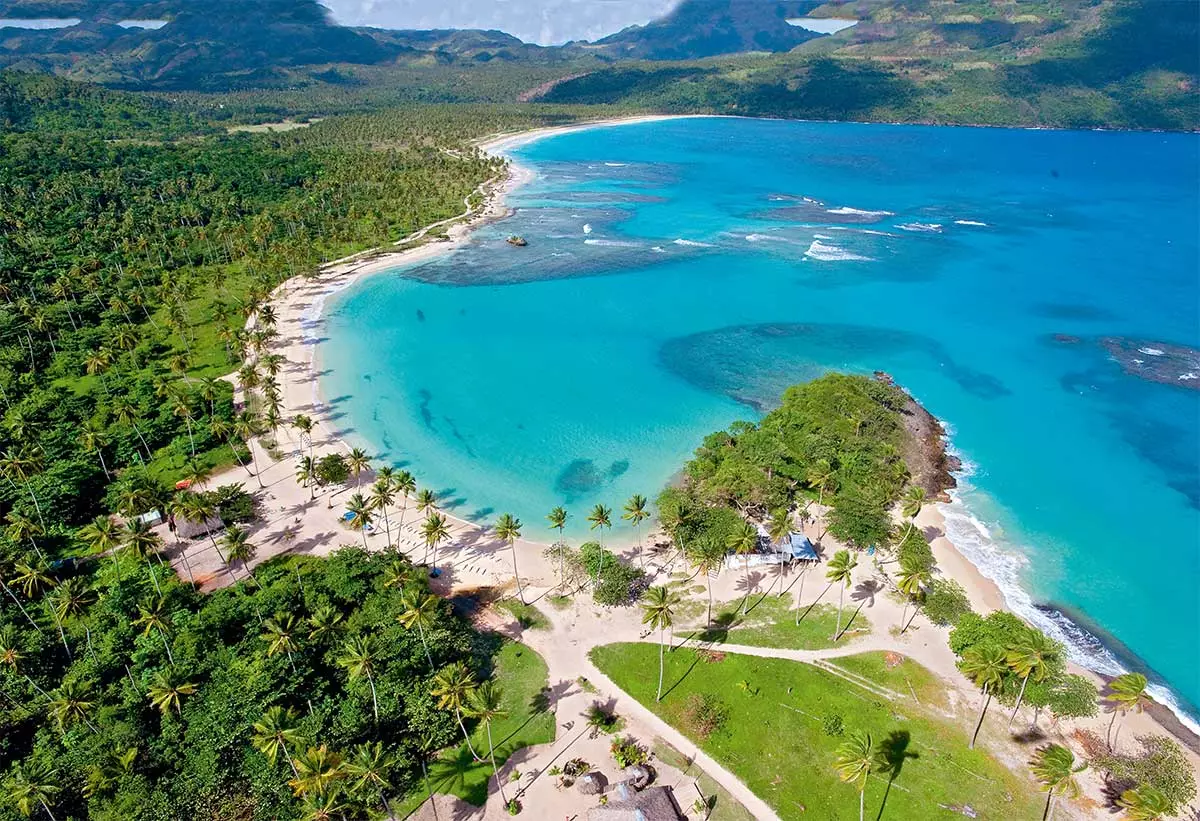
We are going to Playa Rincon
Years ago, when the province of Samaná, in the northwest of the country, was mentioned, very few had been there or expressed any desire to visit it... Today, when speaking of the Dominican Republic, the Samaná peninsula is, together with Punta Cana and Bávaro, among the favorite destinations of those who travel to the country , and this despite being one of the rainiest (but also greenest) regions of the island. The recognition and interest on the part of a more active tourism is the result of a job well done.
In recent times, the development experienced in terms of infrastructures has been important, without detracting from its peculiar orography, its wonderful beaches, its cultural diversity, the peculiar Afro-Caribbean gastronomy, the Taíno footprints that it preserves or the annual visit to the bay of the humpback whales of the North Pacific. In addition, in the Samaná peninsula, the all-inclusive concept of macro-hotels has been losing ground in favor of boutique hotels , much more personal and with smaller dimensions, and other models that have a most authentic spirit
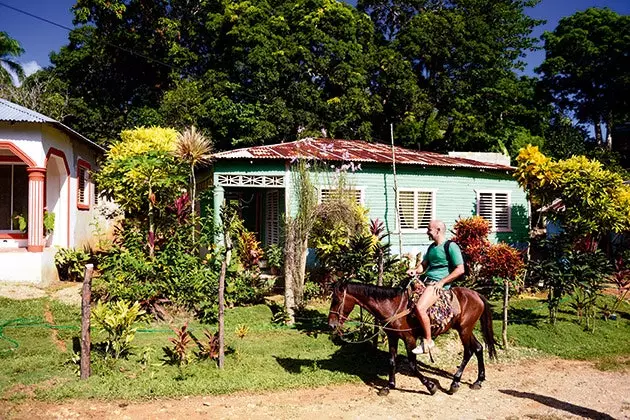
Tour Samaná and discover the panoramic views that each curve hides
Samaná has the shape of a arm of land stuck in the sea, with an area of 1,600 km2 (60 km long and 18 km wide). It wasn't that long ago that it was isolated and far from Santo Domingo, but the results are beginning to show and the connections by land, sea and air are getting better and better. Now it is easy to move around its territory and also to cover the distances that separate some points from others.
To get there, you can rent a vehicle (a 4x4 will always be better) with which it will take an hour and a half to travel along the highway from Santo Domingo; or also take a bus with the company Caribbean Tours, that leaves both from the capital and from the Las Américas airport (4 hours of travel, from 320 Dominican pesos). It also has two airports (an international one, Catey, 30 minutes from Santa Bárbara de Samaná –the capital of the province, which has 51,000 inhabitants– and a national airport for internal flights: Barrel Creek . For those who prefer an adventure flight, there is the option of doing it by plane (3, 5, 7 or 9 passengers with or in a more exclusive and intimate way (with Escapade Samana), which will allow you to enjoy a beautiful landscape with all the range of blues and greens from a bird's eye view.This is a good way to get into this peninsula of coasts populated by coconut palms and seas that hide sunken ships.
As it is, as we have already said, the rainiest and greenest region of the Dominican Republic, it is advisable to travel between mid- January and March, when it is no longer rainy season and the sun shines highlighting its colors. These dates will also allow you to arrive just in time to attend one of the great shows that take place in the bay of Samaná: that of the Humpback whales that come from the North Pacific to mate and give birth. Seeing these huge animals so close is truly impressive. The bay is one of the favorite sanctuaries of this species, of approximately 40 tons per specimen, because in it they take refuge from predators, from the waves (thanks to the underwater reliefs), and can enjoy the warmth of the Caribbean waters.
The sighting is usually assured. There are companies that undertake to carry out the excursion again for free if the meeting does not take place in the first one; but it is advisable to always hire him with boats that carry the yellow flag of the Ministry of the Environment , since they are the ones that respect safety regulations, which affect both crew members and the whales themselves.
The 'parade' begins each year with the arrival of the large mammals on these shores, it continues with the sighting of the males jumping in and out of the water to impress the females and ends with the suckling of the young. There is so much expectation generated that trips to the high seas can be carried out from anywhere in the country, although in the end they all start from Saint Barbara from Samaná and enter the whale sanctuary, and are normally accompanied by a guide and a marine biologist. Some tours make a stop at raised key , a place that deserves a visit by itself. As it is one of the most commercial activities in Samaná, reserving it so as not to coincide with all the cruise ships that stop for a few hours on its public beach will be much more pleasant.
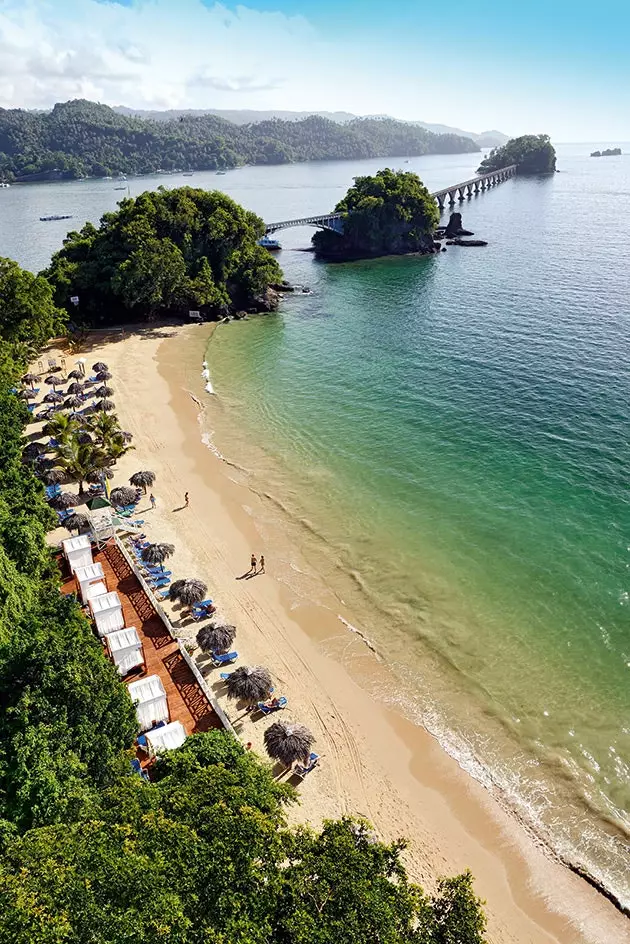
The vegetation reaches the shore of the beaches of Samaná
If you want to get to know this one-kilometer-long islet, consider the possibility of doing so while enjoying the two private beaches of the five-star resort that occupies almost the entirety of it, the Gran Bahía Príncipe Cayo Levantado hotel (organized by the Escapade Samaná agency).
The pier of Santa Bárbara de Samaná, a capital founded at the end of the 19th century by freed black American slaves , is also the starting point for another worthwhile visit: The circuit that, between keys and islets , go through the caves where traces of the Taino Indians can still be seen (pre-Columbian inhabitants, of Arawak origin), who celebrated their rituals and protected from hurricanes inside . To delve into this past, you have to take a boat that heads for a small bay within the Samaná bay: that of San Lorenzo , an authentic paradise for birds (In fact, Cayo de los Pajaros is witness to this overpopulation of winged beings). It is a route similar to the one that could have been done by pirates and freebooters such as the famous English Jack, or the Puerto Rican Roberto Cofresi , the Robin Hood of the seas , who used to hide their stolen treasures.
Today this entire area is part of the Los Haitises National Park , whose surface (21,000 ha) is made up of a landscape of crystalline waters, reefs, karstic rocks, cays, islets and pink and white mangroves that cover almost a hundred square kilometers. So far, some have been explored eighty caves of the park, some of which hide deep galleries and large spaces illuminated by natural light. The so-called cave Saint Gabriel is the largest in the circuit (others are the cave of The Line, The Sand, The Mouth of Hell...) .
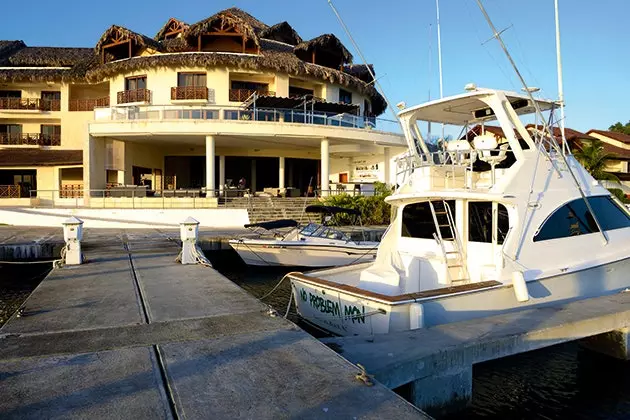
Marina Puerto Bahía
Today this entire area is part of the Los Haitises National Park , whose surface (21,000 ha) is made up of a landscape of crystalline waters, reefs, karstic rocks, cays, islets and pink and white mangroves that cover almost a hundred square kilometers. So far, some have been explored eighty caves of the park, some of which hide deep galleries and large spaces illuminated by natural light. The so-called cave Saint Gabriel is the largest in the circuit (others are the cave of The Line, The Sand, The Mouth of Hell...) .
That of San Gabriel is also the most complete in terms of Taíno rock art: petroglyphs (stone engravings), bas-reliefs and pictograms that have been interpreted as anthropomorphic figures. Other readings speak of newly born (in cases where they appear to be wrapped in sashes) or from people recently deceased , according to studies that have been carried out since 1869. It is a highly recommended visit due to its anthropological interest. The funniest thing is that they seem wave to visitors...
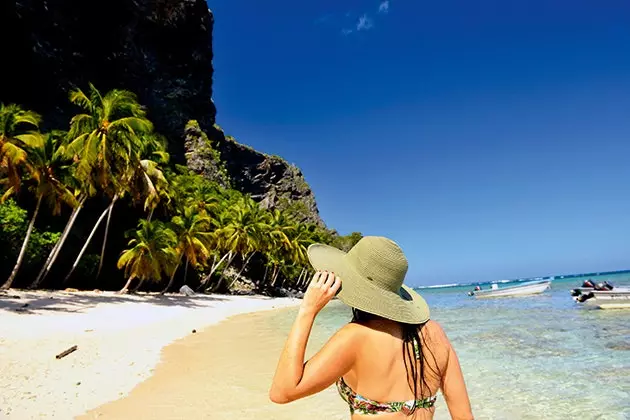
Everything fits in Los Haitises National Park
Most excursions through Los Haitises National Park make a stop for lunch at the refreshing ecological lodge that exists within the park, the Caño Hondo Refuge. A lunch delicious organic food and a swim in one of its ten natural pools put the finishing touch to the day . For whom intimacy and company is more important than the visit and the environment, a more romantic proposal is to cross the bay aboard a catamaran while toasting with champagne with a dreamy sunset with incredible views. All while waiting for the catering service for dinner.
But the idiosyncrasy of the people of this peninsula also invites you to socialize, to chatter your mix of languages (patuá is a hybrid of Spanish, English, French...) and to try your afro-caribbean gastronomy , with many dishes, mainly fish, in which coconut is the main seasoning. Or just go shopping or take a bath. Las Terrenas and the beach of the same name may be the option that best brings together all these elements, since it is the main tourist center of the Samaná Peninsula.
In the bars and restaurants by the sea you have to try the most exotic juices, some very cold beers or some rums at nightfall. Leaving the town, towards one end or the other, there are some of the best beaches. Among them, that of popy tip , the favorite of Dominicans and usual residents of Samaná; either nice beach which, as its name indicates, is an earthly paradise; without forgetting beach coson , perfect for making surfing and body boarding.
But if there is a particularly unique sport in this corner of the planet, it is diving. The best spots for it are hidden port Y Cabo Bastard , strategic points of the Cabo Cabrón National Park, in addition to other good options in the surrounding area Rincon Beach , where is the beachmore beautiful and most virgin of the whole peninsula . Actually it is several beaches in one and it is reached by the road that goes from Samaná to The Galleys (There are organized boat trips from Las Galeras). They are perfect for unfurling the sail and enjoying windsurfing.
* This article is published in the double issue of the Condé Nast Traveler magazine for November number 78. This issue is available in its digital version for iPad in the iTunes AppStore, and in the digital version for PC, Mac, Smartphone and iPad in the Zinio virtual kiosk (on Smartphone devices: Android, PC/Mac, Win8, WebOS, Rim, iPad) . Also, you can find us on Google Play Newsstand.
*** You may also be interested in...**
- Dominican Republic, above all with flavor
- Dominican Republic: the Caribbean without instagram
- The perfect islands to forget about autumn
- The Caribbean in 50 islands
